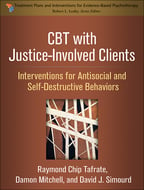
In earlier blogs, we discussed some of the advantages of case planning from a risk-reduction perspective. One of the key challenges in operating from a risk perspective is answering a critical question, Where do mental health symptoms fit when working with justice-involved adolescents and adults?
Major mental disorders are common across justice-involved client (JIC) populations (both in prisons and probation/parole), with prevalence rates exceeding those found in non-justice community samples. This has led many policy makers and practitioners to assume that mental health symptoms have a direct relationship with criminal behavior, and that addressing symptoms will therefore reduce recidivism. This perspective is embedded in the idea that criminal behavior is primarily a product of psychological distress. There is an intuitive appeal to the idea that targeting mental health symptoms will reduce recidivism; however, criminal behavior is largely determined by problems in larger life areas. Focusing on mental health symptoms is unlikely to have a significant impact on future criminality.
Forensically Oriented CBT is Focused on Criminal Risk Domains and Not Symptoms
CBT interventions for common mental health problems are applied with a symptom-focused approach. For example, feelings of worthlessness and reduced social activities are commonly found in depression. Monitoring and challenging thoughts of worthlessness and scheduling rewarding activities would be part of a traditional CBT treatment plan. In contrast, CBT among JICs is focused on criminal risk domains. Thus, a shift is required from a focus on symptoms of psychological distress to the person’s functioning in the major risk domains associated with continued offending. Attention to reducing risk of reoffending rather than symptoms of psychological distress means that practitioners need to be familiar with, and assess, what are commonly referred to as the Central 8 risk domains, (discussed in our previous blogs). The formulation and implementation of interventions to reduce a JIC’s poor decision-making and risky behaviors within those domains is key to reducing reoffending.
So, Where Do Mental Health Symptoms Fit?
The best way to illustrate the complex interrelationship between criminal risk domains and mental health symptoms is to examine a case.
Chloe is a 19-year old who is on probation for breaking and entering. Her arrest occurred in an unoccupied house that was up-for-sale; she was caught in the house with a group of friends smoking pot. As your first session unfolds it becomes obvious that Chloe has been suffering from depressed mood: she sleeps late every day, has a lack of energy, and an absence of optimism and a game-plan for the future. Chloe’s lives with her parents who expressed concern that she had gotten on the “wrong path” since graduating high school.
A few notable events occurred in the past year. First, Chloe was supposed to attend college. Unfortunately, during her senior year of high school she got into a serious car accident and developed panic attacks, intrusive thoughts, and avoided driving altogether. Although she was seeking treatment for her symptoms, Chloe began to drink and smoke pot to reduce her internal distress. Since the majority of her high school peer group moved on to college, she started hanging out with a new group of older friends who would drive her to parties and provided easy access to alcohol and marijuana. She also got involved with a new boyfriend. Chloe’s parents report he is gang-involved and makes a living selling drugs.
Once Chloe started spending time with her new friends she would routinely stay out until the early hours of the morning. She reports that her friends sometimes steal cars and break into houses. She says she goes along with these activities out of concerns about being rejected by the group and also admits she finds it exciting. In the past few months, Chloe has decided that she is no longer interested in going to college because it seems boring. When her parents complain about her lack of future plans, Chloe threatens to move into an apartment with her boyfriend.
There are two common mistakes practitioners can make with this case.
Mistake #1: Assuming that reducing Chloe’s mental health symptoms will reduce her criminal/antisocial behavior.
If Chloe’s probation officer and case manager were to focus solely on alleviating her mental health symptoms (e.g., depressed mood, low energy, panic attacks) it would most likely help her feel better, but unlikely alter her risk of reoffending. In fact, it may be more likely that Chloe gains added energy with which to continue or even escalate her pattern of hanging out late with her friends, using substances, and participating in larcenies. Furthermore, if she gets arrested again over the course of case management, Chloe will not complete her probation successfully and will likely face a period of incarceration -- an experience that typically alters peoples’ life trajectories for the worse, not the better. Strange as it may sound, given these possibilities, it would be best to think beyond her mental health symptoms and put greater attention on reducing Chloe’s risk for criminal behavior. In this light, her current antisocial companions and romantic relationship, substance abuse/misuse, lack of connection to work/school, and maladaptive leisure time come to the forefront as key intervention targets.
Mistake #2: Assuming Chloe’s mental health problems are unimportant or should not be addressed in supervision/ case management.
Of course, Chloe’s mental health problems are not irrelevant. Her symptoms, to some degree, shaped her recent decisions about school and how she spends her time and who she spends it with. Now that these risky patterns are entrenched, her depressed mood and anxious activation are best conceptualized as responsivity factors – the associated symptoms (e.g., lack of energy, pessimism, low mood, panic attacks, and avoidance) can interfere with her ability to work on making changes in the risk-relevant domains of her life. Addressing her symptoms of depression and her anxious avoidance will be helpful in pursuing active interventions around altering social networks, creating prosocial activities, and reducing substance use.
Conclusion
Addressing mental health problems is sometimes necessary to help JICs focus, attend, and participate fully in the interventions that target their criminal risk domains. In cases in which the mental health symptoms are particularly severe, alleviating psychological distress is important so that JICs can be less distracted and more open-minded to working on the risky areas of their lives. Alleviating distress does not replace the importance of intervention focused on lifestyle criminal risk factors most associated with future criminality.
 What works and doesn’t work when using Cognitive-behavioral therapy (CBT)? This is something the authors, Raymond Chip Tafrate, PhD, Damon Mitchell, PhD, & David J. Simourd, PhD, of this blog series have spent a long time studying and have put all they’ve learned in the book: CBT with Justice-Involved Clients: Interventions for antisocial and self-destructive behaviors. We thought our subscribers would be interested in a blog series on this content, knowing so many use or refer their clients to this type of treatment. Therefore, we are pleased to announce a blog series on Adapting CBT for Justice-Involved Clients.
What works and doesn’t work when using Cognitive-behavioral therapy (CBT)? This is something the authors, Raymond Chip Tafrate, PhD, Damon Mitchell, PhD, & David J. Simourd, PhD, of this blog series have spent a long time studying and have put all they’ve learned in the book: CBT with Justice-Involved Clients: Interventions for antisocial and self-destructive behaviors. We thought our subscribers would be interested in a blog series on this content, knowing so many use or refer their clients to this type of treatment. Therefore, we are pleased to announce a blog series on Adapting CBT for Justice-Involved Clients.
The trajectory of the science and practice of cognitive-behavioral therapy (CBT) models began with a focus on internalizing mental health syndromes such as depression and anxiety and was later extended to externalizing problems such as substance misuse, anger dysregulation, and personality pathology. Although CBT has grown into a large collection of interventions applicable to diverse client groups, attention to justice-involved clients (JICs) is substantially more limited. This is noteworthy because CBT has been found to be effective in addressing the self-destructive patterns common among JICs. This suggests that interventions using CBT techniques can alter the criminal risk potential of JICs, which in turn may lead to less risky decision-making and behaviors, and ultimately a safer society.
The practical application of any intervention approach often requires adaptation when delivered to a unique client group; and this occurs with CBT and JICs. We have been fortunate to have been involved in vast activities with JICs over the years. This has included developing and implementing intervention programs, providing training, consultation, and direct service to JICs. We have also worked with front-line criminal justice personnel in both custody and community settings. CBT techniques have been a constant theme in all our work with JICs and criminal justice personnel. Along the way, we have refined what works, eliminated what didn’t work, and examined the impact the interventions had on recidivism. In this blog series we will discuss what we have learned about tailoring CBT when working with JICs within a community corrections context.
|
Raymond Chip Tafrate, PhD |
Damon Mitchell, PhD |
David J. Simourd, PhD |
* These blogs are meant to present brief tips and strategies for agencies, programs, and practitioners. Readers who want more science, history, or detailed descriptions of “how to” conduct forensic CBT interventions may consider the following resource: CBT with justice-involved clients: Interventions for antisocial and self-destructive behaviors.
** There are many terms commonly used to describe people receiving services in criminal justice settings: offender, juvenile delinquent, probationer, parolee, prisoner, inmate, court mandated client, and patient, to name just a few. We commonly use the term justice-involved client (JIC). The abbreviation JIC is not intended to communicate any notion of inherent badness; instead, it’s meant to convey the complexities and challenges associated with the larger context in which intervention is delivered, while sidestepping the pitfalls of pejorative labels.




